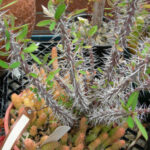Taking care of cactus is relatively easy, notes veteran cactus grower Hazelyn Guerrero of Talisay City, Negros Occidental, Philippines. However, despite the utmost care, mortality can never be avoided so the grower should not be disappointed when such incidents arise. “It may be hard at first, but as you get to know your plants, you’ll become more adept in responding to their needs,” she says.
When acquiring succulents from uplands, Hazelyn says that it is best to bring them to a lower altitude and allow them to acclimatize before bringing them down to the city where the climate is hot. “The plants will be stressed by a sudden temperature or climatic change. Some kinds may be resilient than others, but there are some that could not stand it and they die in just a short while. So your money is just wasted,” Hazelyn laments. When acclimatization is not possible, then she advises against buying plants sourced from the uplands. Instead, she recommends that plant lovers buy from reputable sources during garden shows because their plants have already been allowed to settle in the lowlands for some time before selling. For Hazelyn, she propagates her plants in Talisay, which is about 1,500 feet above sea level, and moves them down to her home in Bacolod. Her Talisay farm, which is nestled at the foothills of Mt. Pulak-pulakan in Negros, is blessed with hot days and cool nights-the climate that cacti love. “It’s so much like in the dessert where they came from that’s why the succulents love it here!” she exclaims.
For her potting mixture, Hazelyn uses mostly river sand combined with some charcoal chips, rice hull, and vermi-compost. For the succulents, she adds some mudpress. The river sand provides looseness to the mixture while the rest of the ingredients have their own nutrients that are good for the plants. “The soil should be porous, not waterlogged, or else the plants will rot,” she reminds. The plants are then watered when the mixture is obviously dry. They don’t need to be watered everyday because succulents store up moisture in their leaves and branches. Hazelyn also uses a foliar spray on her cacti only when there’s excess mixture that was used from her other plants.
Generally, succulents are sun lovers, but Hazelyn has put them in a green house to protect them from insects and too much rain, especially the small, fragile ones. She also acknowledged that each plant has a microclimate, because she noticed that some plants grow well when placed in a certain area of a greenhouse and they deteriorate if moved to another place.
When growing cacti from seeds, she removes the dried berries from the plant, cuts them open, and places the seeds on a paper towel to air-dry for about three weeks to a month. When the seeds are dried, these are then sown in prepared seedling trays.
There are certain kinds though, that she would only recommend to more experienced collectors, such as the Ruby Ball (gymnocalisium), because “they are very delicate. They are difficult to propagate because they are grafted to those varieties that are not so attractive.” The Ruby Ball, although beautiful, does not have chlorophyll so it cannot survive on its own. It has to have a host, Hazelyn explains. “The host may not be attractive, but it provides the nutritional elements that the Ruby Ball needs in order to survive,” she adds. There are also those unattractive columnar cacti that grow so tall but do not offer anything else to see. Hazelyn advises to cut them so that from the cut end, new plants will grow, thus forming natural interesting new shapes. The cuttings may be also be re-planted so the variety is propagated.
As with anything, Hazelyn admits that taking care of cactus may be easy or hard depending on how interested or dedicated a person is. “Like people, each plant has its own needs and if these needs are not met, then they will naturally die,” she imparts.






